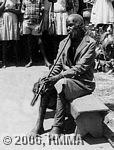






Other names: omukuri, omurere, endere, obunyamurera, ekikuri, enyamurere
The omubanda is a straight cylindrical flute measuring 50 to 55 cm in length and with a diameter of just 2 to 2.5 cm. The omubanda almost always has four finger-holes, three if the flute is not long enough. The material it is made from is either a piece of bamboo, a reed or a lobelia stalk, which is cut off at the desired length and then dried out for several days. The outside of the stalk is smoothed with a knife and the inside is carefully hollowed out with sharp sticks. A U or V shaped notch is burnt at one end for the mouthpiece and four finger-holes are burnt into the underside of the flute. The instrument is then immersed in hot water, grease is rubbed into it and it is then placed in the sun to dry. If cracks begin to appear, banana leaves are wrapped around the flute; this is often done as a preventative measure with this type of delicate flute.
The omubanda is never played by women; this is absolutely taboo. It is a popular solo instrument but it is also played in combination with drums, rattles and singing. What sets a talented player apart from the rest is that he plays in perfect harmony with the singing, he is able to improvise well on the basic melodies and he uses graceful body movements whilst playing.
The endere ensemble, which played at the former royal court of Ankole, is a group of three flutists and some percussionists. The flutes each had their own tone and always played in hoketus figures, in which the musicians take it in turn to play one note which produces a 'hiccupping' effect. This ensemble also comprised an engoma and an engalabi, which were responsible for the rhythmic patterns. The endere ensemble was the best-known and the most appreciated of the three former royal ensembles in Ankole because of its fine musical and artistic qualities.
At the court of Buzimba, a flutist duo was formed that played outstandingly as an ensemble. The duo was rhythmically accompanied by the royal drums of Buzimba.
Today the omubanda is played by all the population groups of Ankole to accompany dance. The Hima herdsmen also play the omubanda whilst they guard their herds.
for more information see also: VAN THIEL, Paul, "Multi-Tribal Music of Ankole. An ethnomusicological study including a glossary of musical terms." Edited by the Royal Museum for Central Africa, Annales, Sciences Humaines, nr 91, 1977, 234 pp.
© KMMA/Paul VAN THIEL